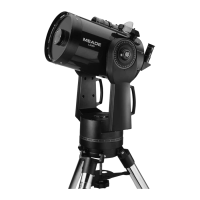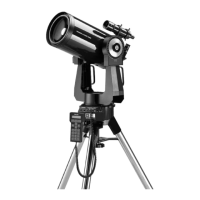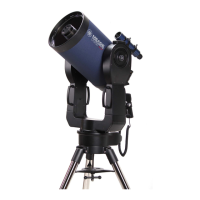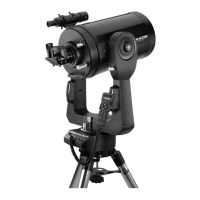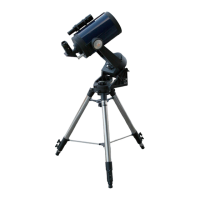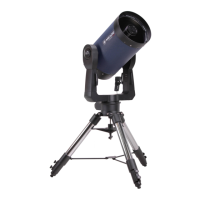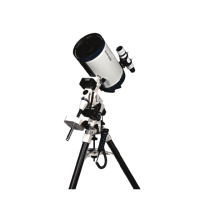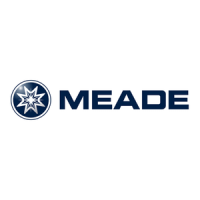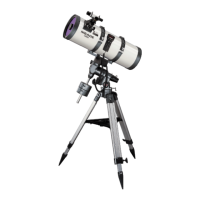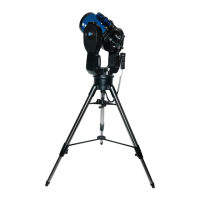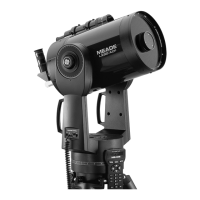Do you have a question about the Meade LX-90 and is the answer not in the manual?
Step-by-step guide to assembling the tripod, telescope, and connecting Autostar.
Diagram labeling all major parts of the telescope and handbox.
Detailed descriptions of parts 1-12, including optical tube, locks, and setting circles.
Detailed descriptions of parts 13-18, including control panel and viewfinder.
Explains the main features and capabilities of the Autostar hand controller.
Details the Autostar LCD display, keys, and navigation methods.
How to use arrow and number keys for data input and menu navigation.
Lists all components included with the LX90 telescope.
Instructions for securely attaching the telescope to the field tripod.
Steps for installing batteries and connecting the Autostar handbox.
Guidance on selecting eyepieces for optimal viewing and magnification.
Instructions for attaching and aligning the telescope's finder scope.
How to manually slew and focus the telescope for observation.
Advice for viewing terrestrial objects, considering atmospheric conditions.
Utilizing the Autostar arrow keys to move the telescope.
Explanation of the nine available slew speeds for telescope movement.
Guidance and tips for observing the Moon's surface features.
Step-by-step guide for the initial setup and configuration of Autostar.
Instructions for positioning the telescope correctly for Alt/Az mode.
General guidance on navigating Autostar's menu structure.
How to set up the telescope to automatically track celestial objects.
A practical demonstration of using Autostar to track a star.
Detailed steps for completing the Easy Align procedure.
Demonstrates selecting and slewing to a celestial object using Autostar.
How to use Autostar's feature to tour celestial objects.
An exercise to practice menu navigation and data entry.
Methods for inputting text and numbers into Autostar.
General guidelines for moving through Autostar's menu system.
Accesses databases of celestial objects like planets, stars, and nebulae.
Provides information on astronomical events like sunrise, sunset, and moon phases.
Options for selecting and using pre-programmed celestial tours.
Alphabetical listing of astronomical terms and Autostar functions.
Accesses features like timer, alarm, and eyepiece calculations.
Configures telescope settings, date, time, and alignment parameters.
Storing and modifying multiple geographic locations for observation.
Procedures for entering custom object coordinates into Autostar.
Steps to prepare the telescope for tracking and viewing satellite passes.
Instructions for creating and formatting custom guided tour files.
Adding, selecting, and surveying stored terrestrial landmark locations.
Using Autostar to identify observed objects in the night sky.
Performing two-star or one-star Alt/Az alignments manually.
Searching the object database using custom search parameters.
Guidelines for cleaning and inspecting telescope optics.
Detailed steps for aligning the telescope's optical system.
Verifying proper function of the telescope's motor drives.
Contact details and procedures for obtaining Meade customer support.
Key technical data and performance metrics for the LX90 telescope.
Technical data for the Autostar hand controller and its capabilities.
Explanation of Right Ascension and Declination for sky mapping.
Describes Easy, One-Star, and Two-Star polar alignment procedures.
Techniques for using setting circles to locate celestial objects.
Information on attaching and using the optional equatorial wedge.
A table of city latitudes to assist with polar alignment adjustments.
Introduction to observing planets, nebulae, and star clusters.
Details on viewing planets like Venus, Mars, Jupiter, and Saturn.
Information on nebulae, star clusters, galaxies, and constellations.
Using star patterns and charts to locate objects in the sky.
A list of bright stars with coordinates for alignment purposes.
Step-by-step guide to assembling the tripod, telescope, and connecting Autostar.
Diagram labeling all major parts of the telescope and handbox.
Detailed descriptions of parts 1-12, including optical tube, locks, and setting circles.
Detailed descriptions of parts 13-18, including control panel and viewfinder.
Explains the main features and capabilities of the Autostar hand controller.
Details the Autostar LCD display, keys, and navigation methods.
How to use arrow and number keys for data input and menu navigation.
Lists all components included with the LX90 telescope.
Instructions for securely attaching the telescope to the field tripod.
Steps for installing batteries and connecting the Autostar handbox.
Guidance on selecting eyepieces for optimal viewing and magnification.
Instructions for attaching and aligning the telescope's finder scope.
How to manually slew and focus the telescope for observation.
Advice for viewing terrestrial objects, considering atmospheric conditions.
Utilizing the Autostar arrow keys to move the telescope.
Explanation of the nine available slew speeds for telescope movement.
Guidance and tips for observing the Moon's surface features.
Step-by-step guide for the initial setup and configuration of Autostar.
Instructions for positioning the telescope correctly for Alt/Az mode.
General guidance on navigating Autostar's menu structure.
How to set up the telescope to automatically track celestial objects.
A practical demonstration of using Autostar to track a star.
Detailed steps for completing the Easy Align procedure.
Demonstrates selecting and slewing to a celestial object using Autostar.
How to use Autostar's feature to tour celestial objects.
An exercise to practice menu navigation and data entry.
Methods for inputting text and numbers into Autostar.
General guidelines for moving through Autostar's menu system.
Accesses databases of celestial objects like planets, stars, and nebulae.
Provides information on astronomical events like sunrise, sunset, and moon phases.
Options for selecting and using pre-programmed celestial tours.
Alphabetical listing of astronomical terms and Autostar functions.
Accesses features like timer, alarm, and eyepiece calculations.
Configures telescope settings, date, time, and alignment parameters.
Storing and modifying multiple geographic locations for observation.
Procedures for entering custom object coordinates into Autostar.
Steps to prepare the telescope for tracking and viewing satellite passes.
Instructions for creating and formatting custom guided tour files.
Adding, selecting, and surveying stored terrestrial landmark locations.
Using Autostar to identify observed objects in the night sky.
Performing two-star or one-star Alt/Az alignments manually.
Searching the object database using custom search parameters.
Guidelines for cleaning and inspecting telescope optics.
Detailed steps for aligning the telescope's optical system.
Verifying proper function of the telescope's motor drives.
Contact details and procedures for obtaining Meade customer support.
Key technical data and performance metrics for the LX90 telescope.
Technical data for the Autostar hand controller and its capabilities.
Explanation of Right Ascension and Declination for sky mapping.
Describes Easy, One-Star, and Two-Star polar alignment procedures.
Techniques for using setting circles to locate celestial objects.
Information on attaching and using the optional equatorial wedge.
A table of city latitudes to assist with polar alignment adjustments.
Introduction to observing planets, nebulae, and star clusters.
Details on viewing planets like Venus, Mars, Jupiter, and Saturn.
Information on nebulae, star clusters, galaxies, and constellations.
Using star patterns and charts to locate objects in the sky.
A list of bright stars with coordinates for alignment purposes.
| Focal Length | 2000 mm |
|---|---|
| Focal Ratio | f/10 |
| Optical Design | Schmidt-Cassegrain |
| GoTo Capability | Yes |
| Aperture | 8" (203.2 mm) |
| Mount Type | Altazimuth |
| Eyepiece(s) | 26 mm Super Plossl (1.25") |
| Motor Drive | Yes |
| Tracking Rates | Lunar |
| Power Supply | 12V DC |
